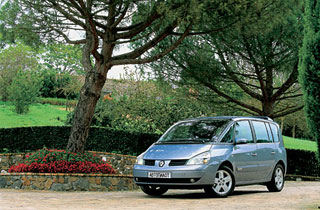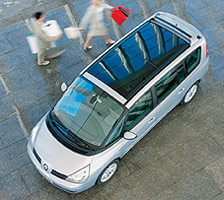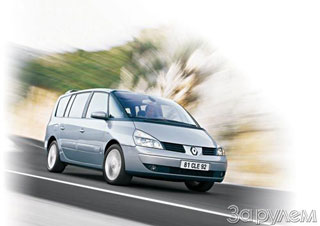Test drive by Renault Espace 2002 - 2006 Minivan
Economical Espace
If under the hood of this large Renault there is diesel, then one fuel tank may be enough for 1000 km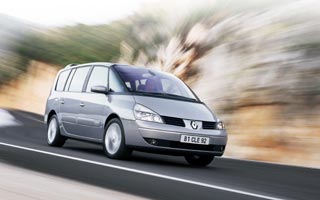 The times when the diesel engine was associated in the minds of motorists only with trucks or SUVs for a long time sunk into oblivion. It is not shameful for diesel fuel today to even season with a sports vein, the benefit of modern diesel engines, retaining the main advantage - efficiency - in terms of power and dynamism are practically not inferior to gasoline engines. What brilliantly proved the minivan Renault Espace IV with a 2.2 DCI engine, on which I had to travel along the roads of Spain. And since the fourth-generation ESPACE remains for most readers of the ESPACE AIT Terra Incognita (the model was presented more than six months ago at the car dealership in Paris, but the Russian consumer has not yet reached), this trip turned into an editorial test drive.
The times when the diesel engine was associated in the minds of motorists only with trucks or SUVs for a long time sunk into oblivion. It is not shameful for diesel fuel today to even season with a sports vein, the benefit of modern diesel engines, retaining the main advantage - efficiency - in terms of power and dynamism are practically not inferior to gasoline engines. What brilliantly proved the minivan Renault Espace IV with a 2.2 DCI engine, on which I had to travel along the roads of Spain. And since the fourth-generation ESPACE remains for most readers of the ESPACE AIT Terra Incognita (the model was presented more than six months ago at the car dealership in Paris, but the Russian consumer has not yet reached), this trip turned into an editorial test drive. Unity of style
If we talk about the exterior of Espace IV, then the task is to realize the modern visual image of the Renault brand - the designers performed perfectly. A related relationship with the ancestors of the new corporate style - Avantime and Vel Satis - is visible, as they say, with the naked eye: the same tense, sharp, angular outlines. The gaze is encouraged by the huge, triangular shape of the headlight, large branded rhombus and truly a huge panoramic windshield. By the way, the darkened body racks create the illusion of continuous glazing, and sitting inside (especially in a version with a glass roof), you feel like in an aquarium. Large wheels, slightly protruding due to the enlarged range behind the body contours, create a feeling of stability and swiftness. In profile, this impression is enhanced by the back of the back of the back tilt, which reminded the rocket stabilizer, and shorter over the previous Espace overhang. Vertically located lights visually continue the rear window. It looks beautiful. However, in general, the back, from my subjective point of view, looks some kind of incomplete, chopped off. It must be a disharmony to the general appearance of the car introduces an almost vertical door in combination with a short rear overhang.
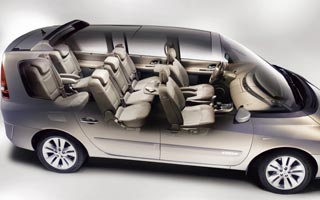 However, we should not forget that we have not just a minivan - the embodiment of utilitarianism - but Espace, which guarantees maximum space for passengers. The inclined door would inevitably reduce the height in the tail of the cabin, infringing the interests of people sitting in the last third row. The creators of the most spacious family car naturally could not be allowed. Indeed, the rear passengers do not feel deprived of themselves: they account for exactly the same number of kubature as the front ones. Yes, and the chairs are the same, with integrated three -point belts, trauma -guided head restraints and a powerful frame that can hold the seat in place even with a serious collision. Only guides would withstand, along which all five passenger seats easily glide on the back and forth.
However, we should not forget that we have not just a minivan - the embodiment of utilitarianism - but Espace, which guarantees maximum space for passengers. The inclined door would inevitably reduce the height in the tail of the cabin, infringing the interests of people sitting in the last third row. The creators of the most spacious family car naturally could not be allowed. Indeed, the rear passengers do not feel deprived of themselves: they account for exactly the same number of kubature as the front ones. Yes, and the chairs are the same, with integrated three -point belts, trauma -guided head restraints and a powerful frame that can hold the seat in place even with a serious collision. Only guides would withstand, along which all five passenger seats easily glide on the back and forth. However, the results of crash tests allow you to do not doubt it. EURONCAP also took five stars in testing by the EURONCAP method. The creators of his successor managed not only to achieve the equally impressive results, but also to improve them. The design of the new ESPACE body uses steel with an ultra -high fluidity limit, which absorbs a greater amount of impact energy, than usual, with deformation. As a result, the energy -absorbing ability of the car body increased 2.5 times compared to its predecessor. The nodes and units located in the front compartment (engine, gearbox, various auxiliary equipment) are designed and placed so that when impact, playing an active role in the programmable deformation of the structure. The energy of lateral blows is absorbed by aluminum door profiles and transmitted to the body racks reinforced with internal panels made of sheet metal, the thickness of which on the middle rack reaches 4.3 mm.
For a detailed description of the passive safety of Espace IV, including eight pillows, belts with multi -stage pretense, a system that prevents dropping from the seat during an accident, etc., perhaps, perhaps, the whole newspaper. Therefore - back to the salon, offering an incredible set of options for transforming the passenger compartment. For example, having launched the front seats 180 degrees, and folding the backs of seats of the middle row, you can turn Espace into a cozy cabin, and, removing all seats, into a roomy van with a useful volume of 2860 liters.
As befits a decent minivan, the salon is replete with all kinds of containers for small baggage. In addition to numerous and even more voluminous, compared with Espace III, clothing departments in the front panel and doors have additional containers for trifles built into the upholstery of the sidewalls of the third row of seats. The total volume of clothing boxes and departments of the new Espace is 100 liters.
I'm sitting high ...
No matter what representatives of Renault claim to the Espace driver, having exhausted the widest possibilities of adjusting the seat and the steering column, I could not feel like in a sedan or hatchback, for example, the minivan remains minivan. However, the creators of Espace IV still worked over the improvement of the ergonomics of the driver's seat. For example, compared to predecessors, the steering wheel (by the way, the same as on Vel Satis and Laguna) is located almost vertically, the gearbox lever is installed above, and the front seats, on the contrary, became closer to the floor.
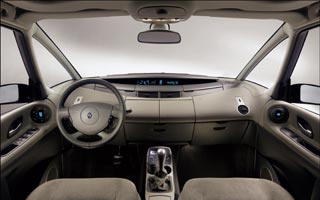 The visibility due to the mentioned enormous area of \u200b\u200bglazing and high planting is practically not caused by, although external mirrors could be larger. But I personally did not like the combination of devices personally. Data on the speed, speed, fuel supply and coolant temperature are excreted in a pleasant blue color to a narrow liquid crystal display, stretching over the front panel from the rack to the rack. It looks beautiful, but the functionality is ready to dispute to hoarse. Firstly, it is not more convenient to read turnout indications than deciphering all these flashing a la Musical Center Small columns, and secondly, the instrument shield is elementary. In addition to indicators and control lamps, the thermometer, watch are present here, the information of the on -board computer, the name and frequency of the radio station, and God the news, are displayed, what else. Well, at least the climatic installation and navigation system are equipped with separate displays.
The visibility due to the mentioned enormous area of \u200b\u200bglazing and high planting is practically not caused by, although external mirrors could be larger. But I personally did not like the combination of devices personally. Data on the speed, speed, fuel supply and coolant temperature are excreted in a pleasant blue color to a narrow liquid crystal display, stretching over the front panel from the rack to the rack. It looks beautiful, but the functionality is ready to dispute to hoarse. Firstly, it is not more convenient to read turnout indications than deciphering all these flashing a la Musical Center Small columns, and secondly, the instrument shield is elementary. In addition to indicators and control lamps, the thermometer, watch are present here, the information of the on -board computer, the name and frequency of the radio station, and God the news, are displayed, what else. Well, at least the climatic installation and navigation system are equipped with separate displays. However, in order to see all this modern color music in action, you need to run the engine by inserting the Renault Card electronic card into the receiving device, and by pressing the Start/Stop button (again, as on Vel Satis, Laguna and Second generation Megane). By the way, for additional money, the card can be taught to perform many any functions, for example, include internal and outdoor lighting in the car, open the doors, remember individual climate settings and audio systems, adjusting seats and mirrors. Renault Card is also capable of storing the identification and registration numbers of the car in memory, and at every exit - remember the level of fuel and oil, the path traveled, tire pressure and the supply of strokes until the next is said to lead the servicemen to violent delight. Finally, such a smart card does not have to be inserted into the receiver: the system recognizes it at a distance and will make the machine with a simple press of the button.
In general, the treasured button is pressed, the electromechanical key, a la Vel Satis, the handbrake is released, you can move. A delightfully silent turbodiesel instantly eats a converged series of six -speed gearboxes - know, manage to turn with a lever. By the way, the speeds switch almost perfectly, easy and clearly.
Vigorously, for the light, dispersing the almost two -ton minivan to a hundred (the speedometer dials flashed, as in the window of the household electric meter to which the industrial machine was connected), I am going in the sixth gear, trying to hold this, rigidly with yellow with a red border signs, speed. The task is unexpectedly difficult: either the gas pedal is hypersensitive, or it simply cannot be patient to check what a single -crew is capable of with the driving qualities of the three -binding. I get out of the local autobahn, where the law allows the Spaniards to relax slightly, and the national temperament provokes to anneal to the whole coil. They rush, indeed, headlong, but polite: the left row is always free, for those who can even quickly. Struggling with temptation to succumb to the general mood, for some time I restrain myself on compromise (taking into account the error of the radar) 130 km/h. The end of doubts was laid with a whistle with a three -bavic Bavarian competitor who flew by.
Having rushed after him, however, I quickly became convinced that contrary to the hot desire of the French by Renault Espace-this is still not the same as the BMW of the 5th series. No, in its class, the car is probably not bad: its driving properties - for Minivan - is beyond praise. But why say that the new Espace is endowed with truly passenia? In direct and in gentle turns, the steering wheel lacks information content, and the first high -speed turn of the high car passed with a solid roll, which completely repelled the hunt to continue the race.
But Espace was frankly pleased with the smoothness of the move and acoustic comfort: neither the noise of the engine, nor the rustle of tires, and the whistle of the wind is practically heard in the salon, is practically not heard. The brakes were also excellent, to check the work of which I had to under the seemingly absolutely innocent circumstances. Noticing something dark on the road, I decided not to make sharp maneuvers, and simply launched a strange object between the wheels. The next moment, there was a strong cotton, which made it almost instinctively hit the brakes, while right away on the side of the road. Having a hundred Espace stopped surprisingly quickly - a rusty heavy metal plate that hit the bottom, and, fortunately, not causing a harm machine, I found only fifteen meters.
But, perhaps, the diesel Espace was most surprised by efficiency: after about 500 km, not done in a sparing mode, a good third remained in the tank. However, this, as it turned out, is not a record. Versions with a 1.9-liter turbodiesel of one refueling are enough for more than a thousand kilometers.
Niche model
The popularity of diesel cars in Europe is growing rapidly. For example, almost 60% of the Spaniards, who bought a new car last year, season it with diesel fuel. The share of diesel cars in the segment E (where ESPACE is positioned) of the Western European market already exceeds 50% and interest in them is growing stably. This trend in the minivan market is even more noticeable. According to studies, more than 70% of the total sales in the EU countries now account for diesel single -combatants.
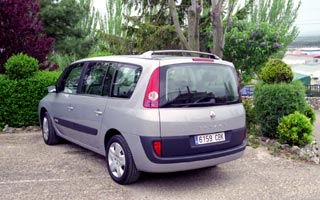 In Russia, the situation is completely different: the percentage of diesel cars is vanishing in all market segments. Demand is not high for minivans. Therefore, Renault does not have any special illusions for the sale of a new Espace, and diesel versions - perhaps the most interesting and practical in the range - will not be supplied to us at all. According to Jana Dorizon, the quality of the Russian diesel fuel, especially in the province, which is incompatible with the life of the engine, so domestic motorists will be offered Espace IV with gasoline engines - two and three -liter ones, responsible for the public relations with the public. Cars will appear with dealers only at the end of this - beginning of next year, so it’s too early to talk about trim levels and prices. Dorizon refused to predict the volume of sales, noticing only that there was no need to hope for a repetition of European success of a single -combat: Espace is a family car, and large families that can afford luxury minivan in Russia, they say, are not yet a lot. Until now, Espace has been acquired mainly by corporate clients for representative purposes. Sales were limited to two or three dozen cars a year.
In Russia, the situation is completely different: the percentage of diesel cars is vanishing in all market segments. Demand is not high for minivans. Therefore, Renault does not have any special illusions for the sale of a new Espace, and diesel versions - perhaps the most interesting and practical in the range - will not be supplied to us at all. According to Jana Dorizon, the quality of the Russian diesel fuel, especially in the province, which is incompatible with the life of the engine, so domestic motorists will be offered Espace IV with gasoline engines - two and three -liter ones, responsible for the public relations with the public. Cars will appear with dealers only at the end of this - beginning of next year, so it’s too early to talk about trim levels and prices. Dorizon refused to predict the volume of sales, noticing only that there was no need to hope for a repetition of European success of a single -combat: Espace is a family car, and large families that can afford luxury minivan in Russia, they say, are not yet a lot. Until now, Espace has been acquired mainly by corporate clients for representative purposes. Sales were limited to two or three dozen cars a year. It is unlikely that the new Espace, which may well be much more expensive than its predecessor, is able to radically change the situation. Moreover, despite the sluggish demand, competition in this segment is enough. Among the rivals are Peugeot 807 and Citroen C8, VW Sharan and Ford Galaxy, Mitsubishi Space Wagon and Hyundai H1.
Andrey Tsybulsky
Video Crash tests Renault Espace 2002 - 2006
Test drives Renault Espace 2002 - 2006
Renault Espace 2002 Krash Test - 2006
Krassh Test: Detailed Information35%
Driver and passengers
10%
Pedestrians







